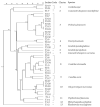Occurrence and Identification of Yeasts in Production of White-Brined Cheese
- PMID: 35744597
- PMCID: PMC9228510
- DOI: 10.3390/microorganisms10061079
Occurrence and Identification of Yeasts in Production of White-Brined Cheese
Abstract
The aim of this study was to reveal the sites of yeast contamination in dairy production and perform taxonomic characterization of potential yeast spoilers in cheese making. Occurrence of spoilage yeasts was followed throughout the manufacture of white-brined cheese at a Danish dairy, including the areas of milk pasteurization, curd processing, and packaging (26 sites in total). Spoilage yeasts were isolated from whey, old cheese curd, and air samples in viable counts of 1.48-6.27 log CFU/mL, 5.44 log CFU/g, and 1.02 log CFU/m3, respectively. Yeast isolates were genotypically classified using (GTG)5-PCR fingerprinting and identified by sequencing of the D1/D2 region of the 26S rRNA gene. The largest yeast heterogeneity was found in old curd collected under the turning machine of molds, where 11 different yeast species were identified. The most frequently isolated yeast species were Candida intermedia, Kluyveromyces marxianus, and Pichia kudriavzevii. The less abundant yeast species included Candida auris, Candida parapsilosis, Candida pseudoglaebosa, Candida sojae, Cutaneotrichosporon curvatus, Cutaneotrichosporon moniliiforme, Papiliotrema flavescens, Rhodotorula mucilaginosa, Vanrija humicola, and Wickerhamiella sorbophila. The awareness on occurrence and taxonomy of spoilage yeasts in cheese production will contribute to a knowledge-based control of contaminating yeasts and quality management of cheese at the dairies.
Keywords: dairy production; spoilage yeasts; white-brined cheese; yeast taxonomy.
Conflict of interest statement
The authors declare no conflict of interest.
Figures


Similar articles
-
Diversity and succession of contaminating yeasts in white-brined cheese during cold storage.Food Microbiol. 2023 Aug;113:104266. doi: 10.1016/j.fm.2023.104266. Epub 2023 Mar 20. Food Microbiol. 2023. PMID: 37098422
-
Occurrence of Yeasts in White-Brined Cheeses: Methodologies for Identification, Spoilage Potential and Good Manufacturing Practices.Front Microbiol. 2020 Oct 15;11:582778. doi: 10.3389/fmicb.2020.582778. eCollection 2020. Front Microbiol. 2020. PMID: 33178163 Free PMC article. Review.
-
The predominance, biodiversity and biotechnological properties of Kluyveromyces marxianus in the production of Pecorino di Farindola cheese.Int J Food Microbiol. 2014 Sep 18;187:41-9. doi: 10.1016/j.ijfoodmicro.2014.06.029. Epub 2014 Jul 5. Int J Food Microbiol. 2014. PMID: 25038503
-
Molecular identification of yeasts associated with traditional Egyptian dairy products.J Food Sci. 2009 Sep;74(7):M341-6. doi: 10.1111/j.1750-3841.2009.01258.x. J Food Sci. 2009. PMID: 19895478
-
Yeasts in different types of cheese.AIMS Microbiol. 2021 Nov 8;7(4):447-470. doi: 10.3934/microbiol.2021027. eCollection 2021. AIMS Microbiol. 2021. PMID: 35071942 Free PMC article. Review.
Cited by
-
A unique metabolic gene cluster regulates lactose and galactose metabolism in the yeast Candida intermedia.Appl Environ Microbiol. 2024 Oct 23;90(10):e0113524. doi: 10.1128/aem.01135-24. Epub 2024 Sep 6. Appl Environ Microbiol. 2024. PMID: 39240082 Free PMC article.
-
Population Structure Based on Microsatellite Length Polymorphism, Antifungal Susceptibility Profile, and Enzymatic Activity of Candida auris Clinical Isolates in Russia.J Fungi (Basel). 2025 Jan 4;11(1):35. doi: 10.3390/jof11010035. J Fungi (Basel). 2025. PMID: 39852454 Free PMC article.
-
The many faces of Candida auris: Phenotypic and strain variation in an emerging pathogen.PLoS Pathog. 2024 Mar 1;20(3):e1012011. doi: 10.1371/journal.ppat.1012011. eCollection 2024 Mar. PLoS Pathog. 2024. PMID: 38427609 Free PMC article. Review.
-
Novel Probiotic Candidates in Artisanal Feta-Type Kefalonian Cheese: Unveiling a Still-Undisclosed Biodiversity.Probiotics Antimicrob Proteins. 2024 Mar 13. doi: 10.1007/s12602-024-10239-x. Online ahead of print. Probiotics Antimicrob Proteins. 2024. PMID: 38478299
-
Advances in the Application of the Non-Conventional Yeast Pichia kudriavzevii in Food and Biotechnology Industries.J Fungi (Basel). 2023 Jan 27;9(2):170. doi: 10.3390/jof9020170. J Fungi (Basel). 2023. PMID: 36836285 Free PMC article. Review.
References
-
- Geronikou A., Srimahaeak T., Rantsiou K., Triantafillidis G., Larsen N., Jespersen L. Occurrence of Yeasts in White-Brined Cheeses: Methodologies for Identification, Spoilage Potential and Good Manufacturing Practices. Front. Microbiol. 2020;11:582778. doi: 10.3389/fmicb.2020.582778. - DOI - PMC - PubMed
-
- Salameh C., Banon S., Hosri C., Scher J. An Overview of Recent Studies on the Main Traditional Fermented Milks and White Cheeses in the Mediterranean Region. Food Rev. Int. 2016;32:256–279. doi: 10.1080/87559129.2015.1075210. - DOI
-
- Hayaloglu A.A. Cheese. Elsevier Ltd.; Malatya, Turkey: 2017. Cheese Varieties Ripened Under Brine; pp. 997–1040. - DOI
-
- Šuranská H., Raspor P., Uroić K., Golić N., Kos B., Mihajlović S., Begović J., Šušković J., Topisirović L., Čadež N. Characterisation of the Yeast and Mould Biota in Traditional White Pickled Cheeses by Culture-Dependent and Independent Molecular Techniques. Folia Microbiol. 2016;61:455–463. doi: 10.1007/s12223-016-0455-x. - DOI - PubMed
Grants and funding
LinkOut - more resources
Full Text Sources

